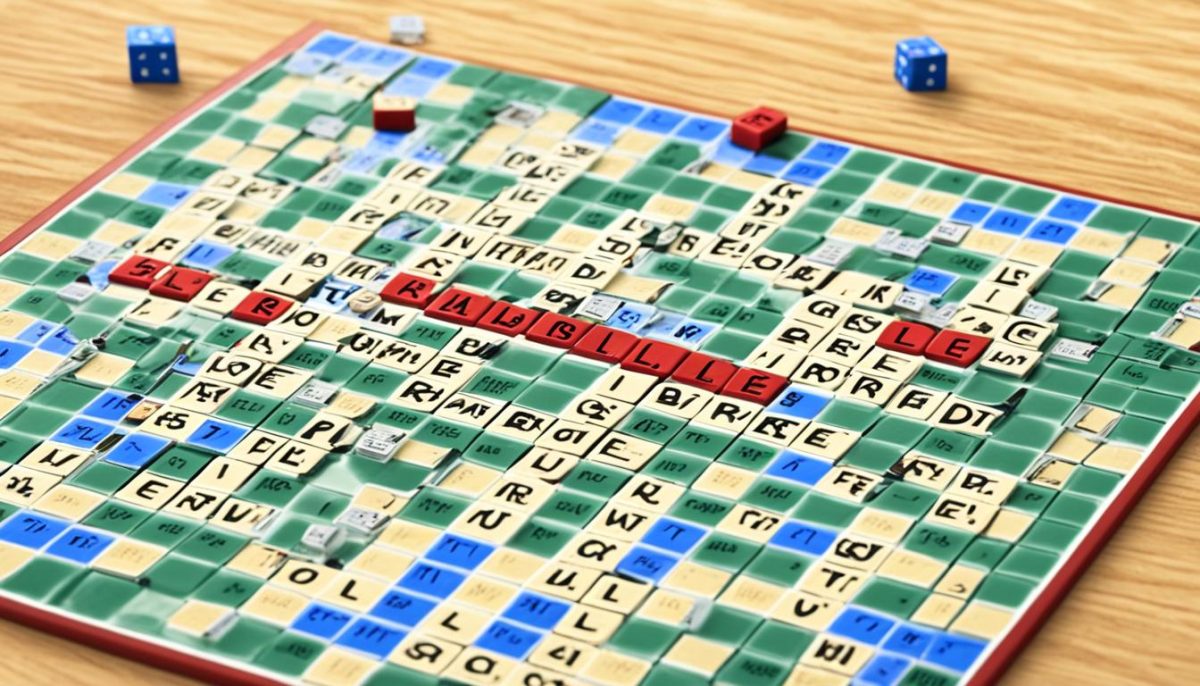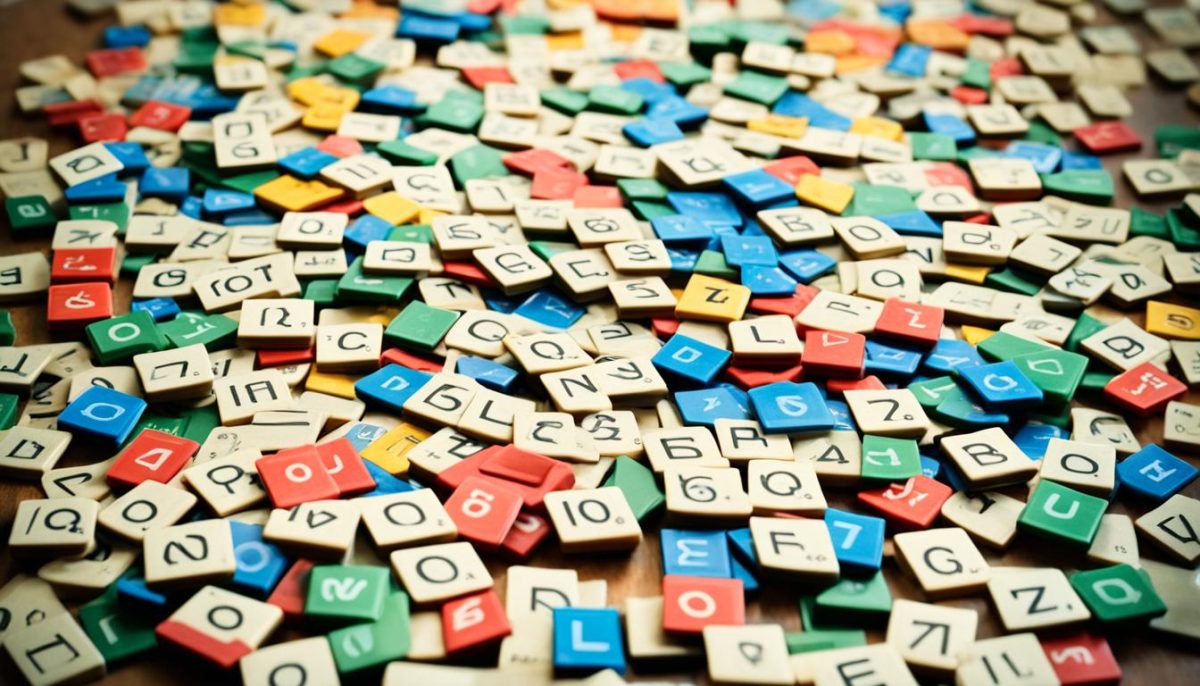When diving into the world of Scrabble, understanding the total Scrabble letters is fundamental. Many might wonder just how many tiles are in a standard game. The answer is 100. This Scrabble tile count is consistent across various editions, all thanks to the meticulous design crafted by Alfred Butts. He aimed for a balanced Scrabble letter inventory, integrating a mix of common vowels and consonants, plus a carefully limited number of high-point letters.
Understanding the Letter Distribution in Scrabble
The distribution of Scrabble tiles is meticulously planned to mirror the frequency of letters in the English language. This balanced approach is essential for both casual and competitive gameplay, allowing for a fair mix of high-frequency and rare letters. Let’s dive deeper into how these tiles are allocated and their impact on strategy.

Scrabble Tile Breakdown
The Scrabble tile distribution is designed with strategic gameplay in mind. Here’s a comprehensive breakdown:
| Letter | Number of Tiles | Point Value |
|---|---|---|
| A | 9 | 1 |
| B | 2 | 3 |
| C | 2 | 3 |
| D | 4 | 2 |
| E | 12 | 1 |
| F | 2 | 4 |
| G | 3 | 2 |
| H | 2 | 4 |
| I | 9 | 1 |
| J | 1 | 8 |
| K | 1 | 5 |
| L | 4 | 1 |
| M | 2 | 3 |
| N | 6 | 1 |
| O | 8 | 1 |
| P | 2 | 3 |
| Q | 1 | 10 |
| R | 6 | 1 |
| S | 4 | 1 |
| T | 6 | 1 |
| U | 4 | 1 |
| V | 2 | 4 |
| W | 2 | 4 |
| X | 1 | 8 |
| Y | 2 | 4 |
| Z | 1 | 10 |
| Blank | 2 | 0 |
Frequency of Each Letter
The most frequent letter in Scrabble is ‘E,’ which aligns with its common usage in the English language. Understanding Scrabble letters frequency is vital, as it assists in predicting the availability of tiles and strategizing your plays. High-frequency letters like ‘A’ and ‘I’ appear nine times each, while rarer letters like ‘Q’ and ‘Z’ appear only once, making them high-value targets in your strategy.
Importance of Letter Distribution
The Scrabble tile distribution plays a crucial role in gameplay strategy. Knowing the Scrabble letters frequency enables players to utilize tiles more effectively. Strategic tile usage is imperative to outscore your opponents, as it involves calculating probabilities and making optimal word choices. Players often analyze tile distribution closely, using expertise to maximize their score potential and improve their overall game strategy.
How the Number of Letters Affects Gameplay
The finite number of letters in Scrabble imposes a distinct dynamic on the game’s flow. Each player’s understanding and utilization of Scrabble strategy are significantly influenced by the letter count impact.
Knowing the number of each letter allows for more tactical moves to be planned, enhancing gameplay dynamics. For example, being aware that only one “Q” tile exists can influence whether to hold onto a “U” tile, anticipating its eventual use in a high-scoring word. This anticipation and planning are key components of a solid Scrabble strategy.

Effective tile management is pivotal. The distribution ensures that players must think ahead and count on their letter combinations wisely. This knowledge aids in creating higher-scoring words and in predicting an opponent’s potential moves, adding a strategic layer that enriches Scrabble gameplay dynamics.
Here is a closer look at letter counts and their impact:
| Letter | Quantity | Points | Game Impact |
|---|---|---|---|
| E | 12 | 1 | High frequency, commonly used for multiple combinations |
| A | 9 | 1 | Essential for creating base words |
| Q | 1 | 10 | Rare, high-value, influences holding the “U” tile |
| Z | 1 | 10 | High-value, strategic placement crucial |
In conclusion, understanding the letter count impact is essential for mastering Scrabble strategy. It allows players to craft moves that not only optimize their scores but also foresee and counter their opponent’s tactics. Whether you’re a novice or a seasoned player, keeping these aspects in mind can significantly elevate your Scrabble gameplay dynamics.
Many Letters Scrabble Game: Details and Facts
Scrabble games come in various editions and special versions, but one thing remains unchanged: the letter distribution. Whether you’re playing the classic game or a themed edition, the fundamental composition of letter tiles doesn’t vary. This consistency is crucial because it ensures a level playing field and allows players to transfer their skills from one version to another without additional learning curves.
Consistency Across Different Versions
Scrabble’s uniformity in letter distribution means that, regardless of whether you’re using the original board or a limited edition like Star Wars Scrabble or the Harry Potter edition, you will encounter the same strategic opportunities. The familiar distribution helps maintain the competitive integrity of the game, making it fair and challenging across all formats. This reliability in letter count and types is why even seasoned players find little difficulty in switching between different editions.
Strategies Based on Available Letters
Understanding and leveraging the fixed letter distribution allows players to develop letter-based Scrabble strategies. These strategies might include careful tracking of high-value letters like ‘Q’ and ‘Z’ or focusing on less-used but versatile letters such as ‘S’ for creating plurals. Recognizing patterns and probabilities in tile draws can immensely boost your chances of forming high-scoring words. Resources from seasoned Scrabble players and online strategy guides often emphasize the importance of mastering these tactics.
Maximizing Your Score with Available Tiles
Maximizing scores in Scrabble involves more than just knowing a plethora of words—it’s about strategic tile placement and timely use of premium squares. High-score Scrabble tactics often revolve around making optimal use of double and triple letter and word score tiles. Additionally, balancing your rack to maintain a good mix of vowels and consonants can make a significant difference in gameplay. By integrating these insights into your playstyle, you’ll find yourself not just participating but excelling in the game.

